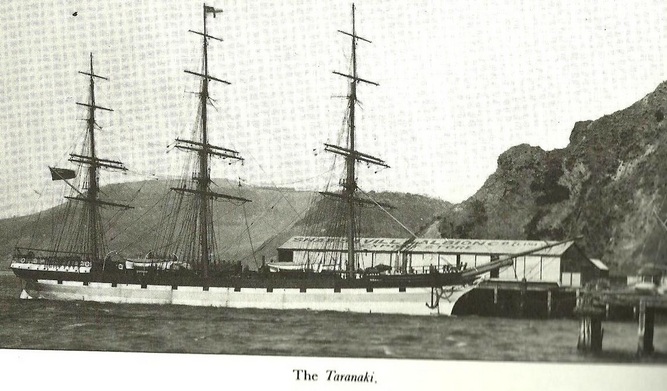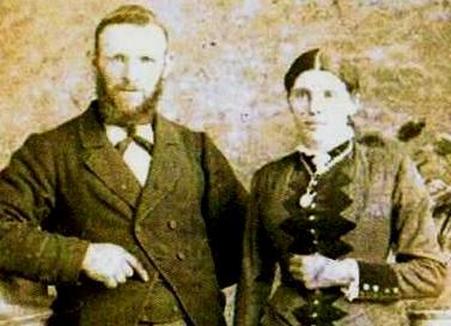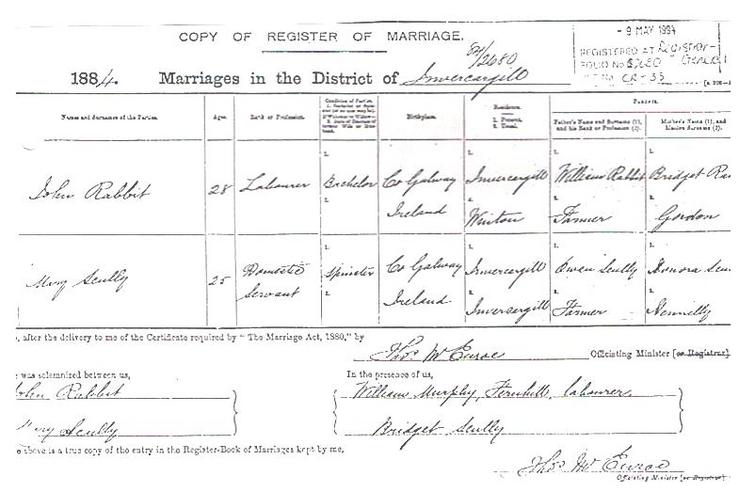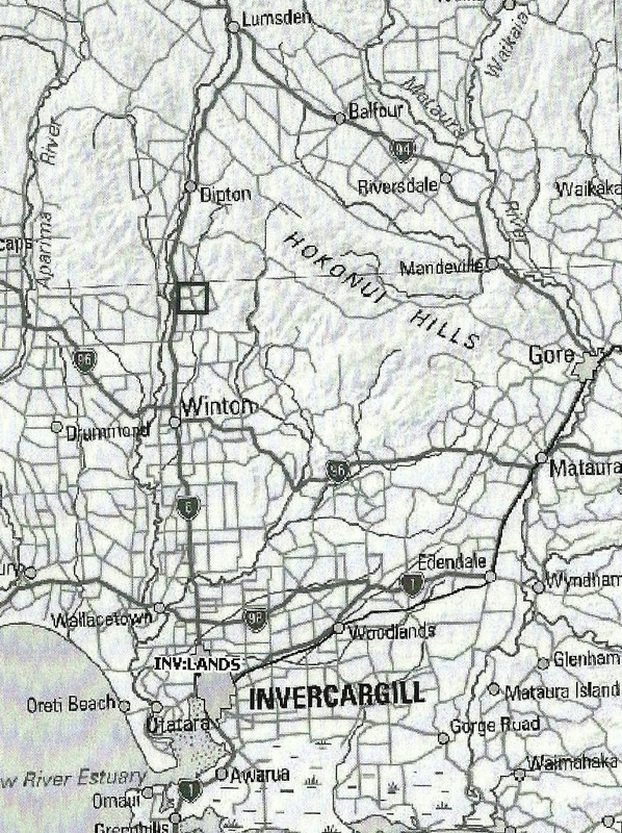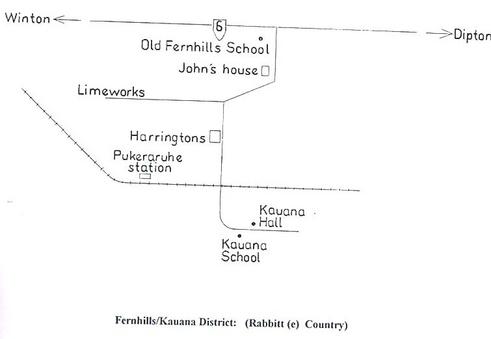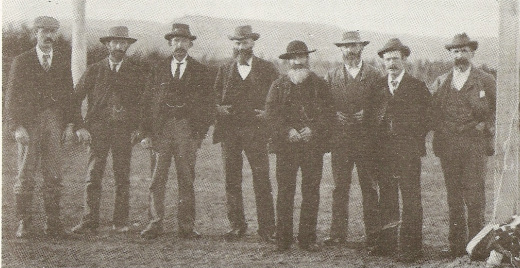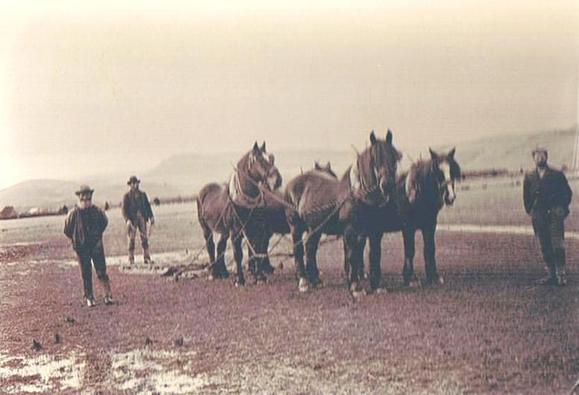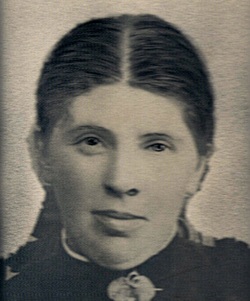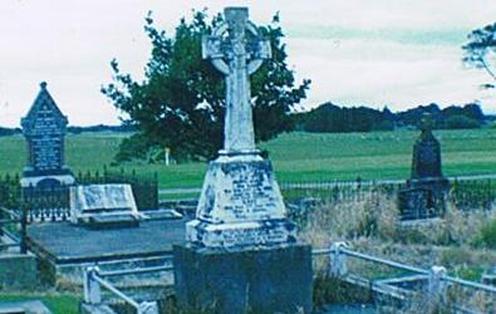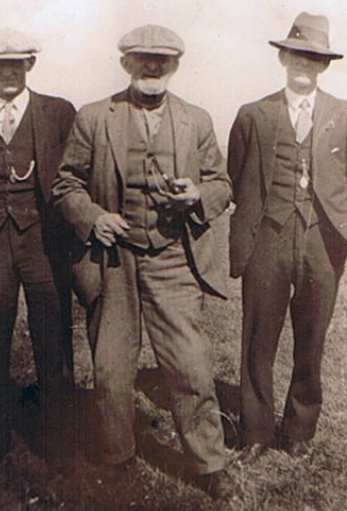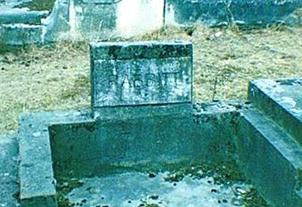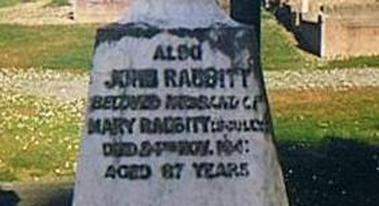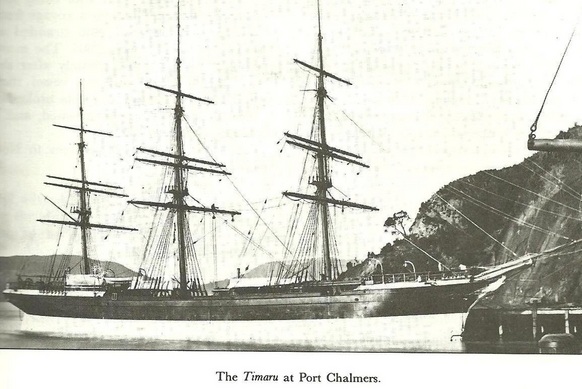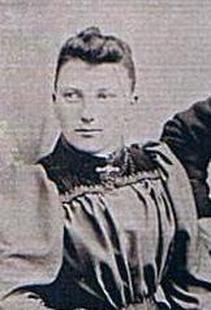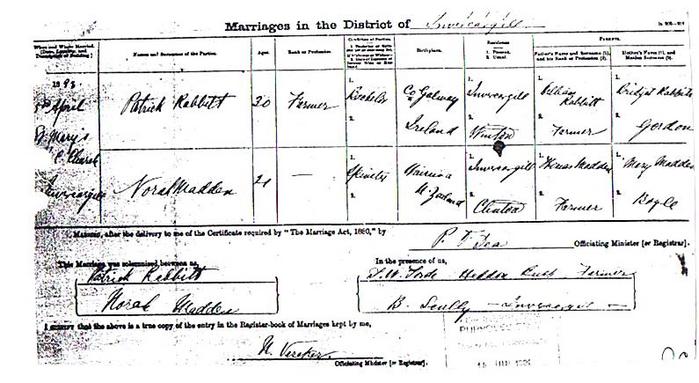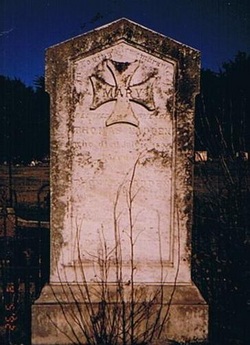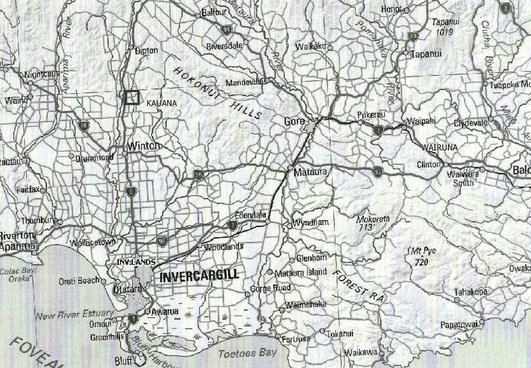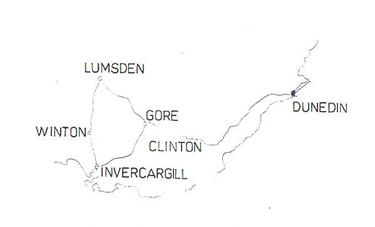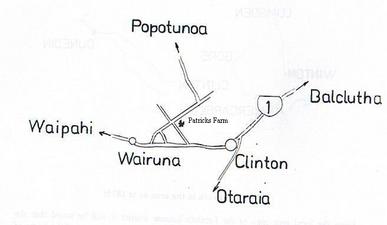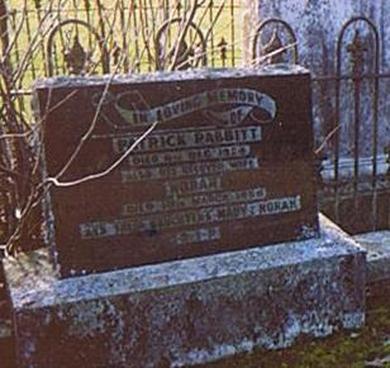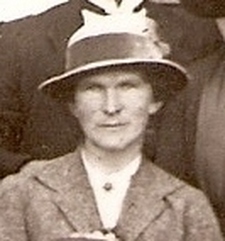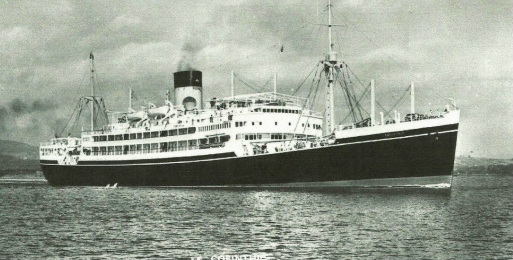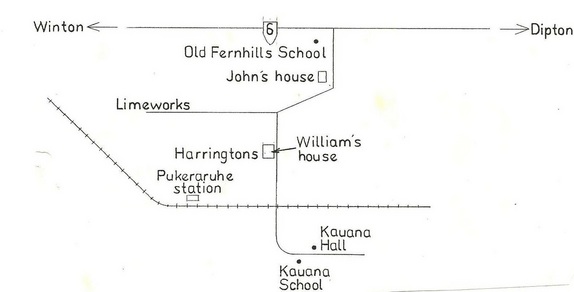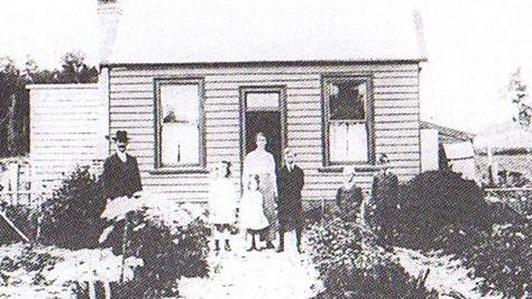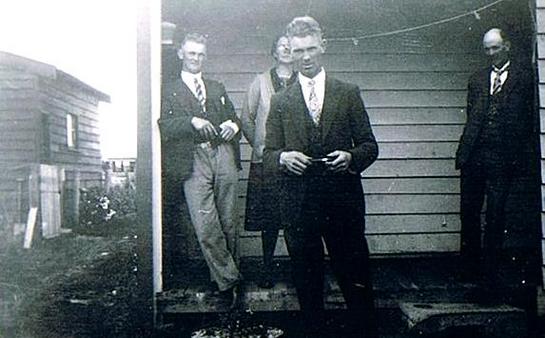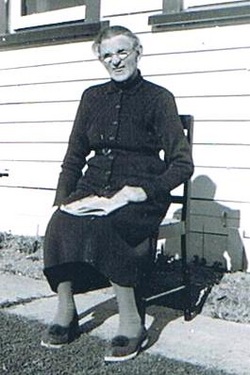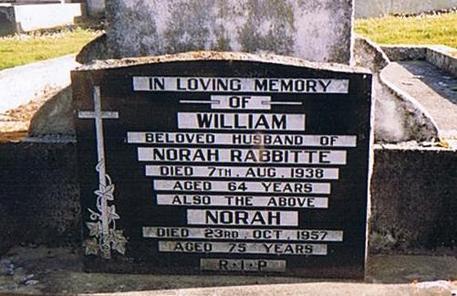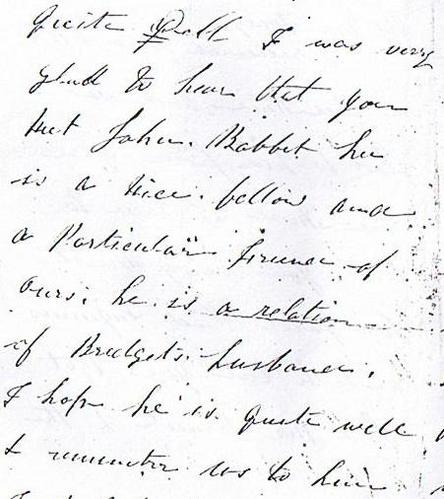The First Generation in New Zealand
John Rabbitt: (1855 - 1941)
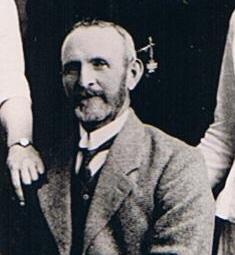
John Rabbitt was the first member of this Rabbitt family to come to New Zealand. Christening records confirm John was christened on 27 December 1855, in the Parish of Lackagh. The sponsors were Michael Greaney and Catherine Rabbit. This appearance of Catherine's name as sponsor is further evidence supporting the view that John's father had a sister or possibly a sister in law, named Catherine.
In his early life John assisted his parents on the Grange farm. At the age of 23 years, John left his parents and brothers and sisters, and set out to make a new life in New Zealand. He left from Clyde in Scotland, and travelled to New Zealand on the sailing ship TARANAKI.
Following his arrival at Port Chalmers in early 1879, John lived in Dunedin for at least 2 years as he established himself in his new country. He is recorded on the 1881 Electoral Roll for the electorate of Roslyn, in Dunedin. He later lived in the Southland area, moving around the northern and central Southland districts providing farm labour as was the norm in those times.
John purchased of 5 acres of land in the Fernhills/Kauana district near Winton, in Central Southland. This purchase is confirmed from the 1882 List of Freeholders. The Fernhills/Kauana district is located about 10 miles north of Winton, and the railway through the area was opened in 1875.
By 1880 he had met his wife to be; Mary Scully, who at that time was living in Invercargill.
John purchased of 5 acres of land in the Fernhills/Kauana district near Winton, in Central Southland. This purchase is confirmed from the 1882 List of Freeholders. The Fernhills/Kauana district is located about 10 miles north of Winton, and the railway through the area was opened in 1875.
By 1880 he had met his wife to be; Mary Scully, who at that time was living in Invercargill.
Mary Scully was also originally from County Galway, having been born there in about 1858. Christening records confirm Mary was christened in the district of Annaghdown Galway, on 19 December 1858. Mary was the daughter of Owen Scully and Honora (nee Hennelly); of Cloonboo, in Galway. The Scully family had been residents of the Cloonboo district for many generations. Mary's siblings included Bridget, (born 1861); Michael, (born 1864), Honor, (born 1867), and Winifred. Some of this family also came to New Zealand.
Mary had been in New Zealand since 1879, having arrived in Bluff on the sailing ship WESTERN MONARCH in February of that year. The shipping record states she was then aged 21 years, and her occupation is given as “domestic servant.” There is evidence from the correspondence between John and his family in Ireland, that the Rabbitt and Scully families were well known to each other in Galway.
Other members of Mary's family known to be in New Zealand in the early 1880's included; her sister Bridget, who later married Walter Hynes; her aunt Bridget Kane of Merton in North Otago; and her cousins John Cahill, and Michael Scully.
John Rabbit and Mary (nee Scully), were married at St Mary's Church in Invercargill, on the 28th August 1884. The witness' at their wedding were;
Bridget Scully (Mary's sister).
William Murphy (John's neighbour, from the Fernhills/Kauana district).
See the following copy of the marriage certificate;
Mary had been in New Zealand since 1879, having arrived in Bluff on the sailing ship WESTERN MONARCH in February of that year. The shipping record states she was then aged 21 years, and her occupation is given as “domestic servant.” There is evidence from the correspondence between John and his family in Ireland, that the Rabbitt and Scully families were well known to each other in Galway.
Other members of Mary's family known to be in New Zealand in the early 1880's included; her sister Bridget, who later married Walter Hynes; her aunt Bridget Kane of Merton in North Otago; and her cousins John Cahill, and Michael Scully.
John Rabbit and Mary (nee Scully), were married at St Mary's Church in Invercargill, on the 28th August 1884. The witness' at their wedding were;
Bridget Scully (Mary's sister).
William Murphy (John's neighbour, from the Fernhills/Kauana district).
See the following copy of the marriage certificate;
Note that the maiden name of John's mother is given on the certificate as GORDON, whereas the correct name as confirmed from the Irish records is GOLDING. This is not the only occasion when this particular mistake has been made in the official records.
Apparently because of the heavy Irish accent with which Bridget, (nee Golding), spoke, nobody was sure what name she was actually saying when she spoke her maiden name! So, for some, the name GORDON was settled on as being the maiden name.
This is a map of the area, showing the Kauana district is shown in relation to Winton and Invercargill.
Apparently because of the heavy Irish accent with which Bridget, (nee Golding), spoke, nobody was sure what name she was actually saying when she spoke her maiden name! So, for some, the name GORDON was settled on as being the maiden name.
This is a map of the area, showing the Kauana district is shown in relation to Winton and Invercargill.
After their marriage in 1884, John and Mary lived and worked on the original 5 acres of land and so began a long association of the Rabbitt family name with the Fernhills/Kauana district.
The land originally owned by John, was adjacent to the junction with the main Winton - Dipton roadway and close to the original Fernhills school. Later some of this land was sold for the developments of a lime works and John bought two further blocks of land in the area.
The following local area map shows the particular area where the Rabbitt (e) name was to become so well established.
The land originally owned by John, was adjacent to the junction with the main Winton - Dipton roadway and close to the original Fernhills school. Later some of this land was sold for the developments of a lime works and John bought two further blocks of land in the area.
The following local area map shows the particular area where the Rabbitt (e) name was to become so well established.
At some early stage John built a house on this original property located adjacent to the Fernhills School. It is believed the original district Community Hall was also located in the vicinity. In the 1880 - 1900 period travel was not easy and often relatively small areas/districts were given individual names. This certainly happened in the Fernhills/Kauana area where quite small areas such as Harringtons and Pukearuhe were named separately. The name Pukearuhe is the Maori word for “ferny hill or root of the ferny hill”.
In those early times the condition of the land would have been far removed from that found in the district today. John and Mary developed land which apparently was extremely swampy and hard to drain, and in those times life was hard with few luxuries. It is probable John was involved in pioneering the drainage methods that were first developed in the district.
Over the next 16 years John and Mary produced a family of 10 children. The 6 boys and 4 girls were all born in the Fernhills/ Kauana district. The first of their family was born in 1885 and additions occurred at regular intervals through until 1901. It is likely there are some clues to family history in the names John and Mary have chosen for their family. The names are;
William Martin born 1885
Michael born 1887
John born 1888
Eugene born 1890
Mary born 1892
Norah Anne born 1894
Patrick James born 1896
Bridget Mary & Thomas (twins) born 1899
Winifred Eleanor born 1901
The above children attended the original Fernhills school which was opened in 1883. Later when the school was relocated in 1911 to the area known as Kauana, John and Mary’s children attended at that school. John was a member of the school committee in 1886, 1889 to 1892, 1894, 1895, 1899 to 1902 and 1912 to 1917. School records show that Mary was at one stage employed as the school cleaner.
In those early times the condition of the land would have been far removed from that found in the district today. John and Mary developed land which apparently was extremely swampy and hard to drain, and in those times life was hard with few luxuries. It is probable John was involved in pioneering the drainage methods that were first developed in the district.
Over the next 16 years John and Mary produced a family of 10 children. The 6 boys and 4 girls were all born in the Fernhills/ Kauana district. The first of their family was born in 1885 and additions occurred at regular intervals through until 1901. It is likely there are some clues to family history in the names John and Mary have chosen for their family. The names are;
William Martin born 1885
Michael born 1887
John born 1888
Eugene born 1890
Mary born 1892
Norah Anne born 1894
Patrick James born 1896
Bridget Mary & Thomas (twins) born 1899
Winifred Eleanor born 1901
The above children attended the original Fernhills school which was opened in 1883. Later when the school was relocated in 1911 to the area known as Kauana, John and Mary’s children attended at that school. John was a member of the school committee in 1886, 1889 to 1892, 1894, 1895, 1899 to 1902 and 1912 to 1917. School records show that Mary was at one stage employed as the school cleaner.
John is included in the above photograph taken in 1902, at a district gathering to mark the end of the Boer War. John is second from the left in the photo. (Note the flag at the base of the flag pole.)
John Rabbit is shown in the following excellent photograph, known to have been taken about the turn of the century. He is the person, second from the left in the photo, in charge of the team of horses. At the time of this photo John was approximately 45 years of age, and he had been settled in the Fernhills/Kauana district for about 15 years.
John Rabbit is shown in the following excellent photograph, known to have been taken about the turn of the century. He is the person, second from the left in the photo, in charge of the team of horses. At the time of this photo John was approximately 45 years of age, and he had been settled in the Fernhills/Kauana district for about 15 years.
As a surviving piece of family history the photo is a very special one. It includes the original New Zealand settler (John) working on the land with a team horses. The area looks like the Fernhills area and the photo shows the original boggy ground. Probably the work being done is to drain the land. Unfortunately the other men in the photo are un-named, but it can be presumed they were either neighbours or other Rabbitt family members.
In 1907 the family was shaken by the death of their mother Mary (nee Scully), who passed away at Fernhills, on 24 June 1907. Mary was only 46 years of age, and her cause of death is given as pneumonia followed by cardiac failure.
In 1907 the family was shaken by the death of their mother Mary (nee Scully), who passed away at Fernhills, on 24 June 1907. Mary was only 46 years of age, and her cause of death is given as pneumonia followed by cardiac failure.
During her lifetime Mary would have seen the death of three of her children. At the time of her death Mary’s youngest child, Winifred Eleanor was just 6 years of age, and the oldest child, William Martin, was 21 years of age.
Mary is buried with the members of her family who predeceased her, at the Winton Cemetery. The following is a photograph of the headstone over their grave. Note that the style of the headstone is of the type usually found in Ireland.
Mary is buried with the members of her family who predeceased her, at the Winton Cemetery. The following is a photograph of the headstone over their grave. Note that the style of the headstone is of the type usually found in Ireland.
Mary was obviously a woman of strong character to have travelled independently to New Zealand as a teenager, and faced the hardships and uncertainties of life in a new country. She was the mother of 10 children born in a 16 year period, and her death would have been sorely felt by the family. Following the death of his wife, John continued to farm in the Fernhills/Kauana district, and increased his holding.
About 1909/1910, John made a return visit to his family in Galway, Ireland. By this time John's father, William, had passed away in 1897, but his mother Bridget was still alive at the time of his visit. The photograph of John and his brother (Fr Paul) shown earlier in the review was taken during this trip.
It is almost certain that during his visit to Galway, John persuaded his youngest brother William, to come to New Zealand to live.
About 1909/1910, John made a return visit to his family in Galway, Ireland. By this time John's father, William, had passed away in 1897, but his mother Bridget was still alive at the time of his visit. The photograph of John and his brother (Fr Paul) shown earlier in the review was taken during this trip.
It is almost certain that during his visit to Galway, John persuaded his youngest brother William, to come to New Zealand to live.
In his retirement John lived with members of his family within the Southland area. John passed away in Invercargill on 24 November 1941. He was 87 years of age and his cause of death is given as hypostatic pneumonia, and senility. It is worth noting that although John was the oldest in a family of seven, he out-lived his four brothers, and one of his two sisters. John’s youngest sister Bridget, born in 1868, was the only one of his siblings to survive him - she died in Ireland in 1949.
John is buried at the Winton Cemetery, although in a separate plot to other members of his family. Never the less his name is also shown on the headstone over the graves of the other members of his family. The following shows the headstone on his grave and the headstone where his name is also included on the family headstone.
John is buried at the Winton Cemetery, although in a separate plot to other members of his family. Never the less his name is also shown on the headstone over the graves of the other members of his family. The following shows the headstone on his grave and the headstone where his name is also included on the family headstone.
Tombstones bearing the name of John Rabbitt at the Winton Cemetery.
Patrick Rabbitt (1858 - 1924)
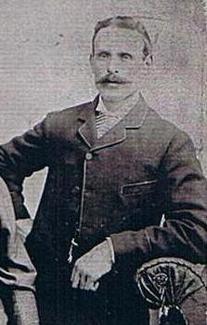
Patrick Rabbitt was the second member of this Rabbitt family to come to New Zealand. Patrick was the second of the five sons of William Rabbitt (1823- 1897), and Bridget (nee Golding); (1836 -1914). He was born early in 1858, and sponsors at his christening were Edward Rabbit, and Sally Hanly. It is a reasonable assumption Edward Rabbit was an adult relative of Patrick’s parents. Sally Hanly was a neighbour from Grange.
Until the age of 23/24 years, Patrick assisted on his parent's farm, at Turloughmore in Galway. In 1882 he left Ireland to start a new life in New Zealand, just as his older brother John, had done three years before him.
Patrick left the United Kingdom on the sailing ship TIMARU which departed from Plymouth, in England, on 20 April 1882. The voyage out to Port Chalmers, near Dunedin, took 74 days.
Until the age of 23/24 years, Patrick assisted on his parent's farm, at Turloughmore in Galway. In 1882 he left Ireland to start a new life in New Zealand, just as his older brother John, had done three years before him.
Patrick left the United Kingdom on the sailing ship TIMARU which departed from Plymouth, in England, on 20 April 1882. The voyage out to Port Chalmers, near Dunedin, took 74 days.
Upon his arrival in New Zealand on 4 July 1882, Patrick took up the ownership of 5 acres of land at Fernhills in Southland, nearby to the original land owned by his older brother, John.
This land ownership is proven from the1882 List of Land Free Holders in New Zealand, where Patrick is shown as the owner of 5 acres of land, at Fernhills. This land had a government valuation of 13 pounds.
Over the next few years Patrick worked the land he owned, and supplemented his income by travelling around the Southland/Otago area providing farm labour, as was the norm in those times. By the early 1890’s Patrick had met with his mother's first cousin; - Thomas Madden. Thomas Madden was originally from Headford in Galway, Ireland, and had been in New Zealand since 1862. For most of that time he had been farming at Wairuna, near Clinton in South Otago. He was the owner of 132 acres and an adjacent block of 160 acres, was farmed by a Daniel Madden – presumably Thomas’ brother. The significance of this point, as will be seen later, lies in the use of the first name - Daniel.
Thomas Madden and his wife Mary (nee Boyle), who was also from Galway, had one daughter - Norah Ann Madden, who was born at Wairuna in 1872.
Patrick Rabbitt married Norah Ann Madden, at St. Mary's Catholic Church, Invercargill, on 5 April 1893.
This land ownership is proven from the1882 List of Land Free Holders in New Zealand, where Patrick is shown as the owner of 5 acres of land, at Fernhills. This land had a government valuation of 13 pounds.
Over the next few years Patrick worked the land he owned, and supplemented his income by travelling around the Southland/Otago area providing farm labour, as was the norm in those times. By the early 1890’s Patrick had met with his mother's first cousin; - Thomas Madden. Thomas Madden was originally from Headford in Galway, Ireland, and had been in New Zealand since 1862. For most of that time he had been farming at Wairuna, near Clinton in South Otago. He was the owner of 132 acres and an adjacent block of 160 acres, was farmed by a Daniel Madden – presumably Thomas’ brother. The significance of this point, as will be seen later, lies in the use of the first name - Daniel.
Thomas Madden and his wife Mary (nee Boyle), who was also from Galway, had one daughter - Norah Ann Madden, who was born at Wairuna in 1872.
Patrick Rabbitt married Norah Ann Madden, at St. Mary's Catholic Church, Invercargill, on 5 April 1893.
Therefore, like his older brother, Patrick married into a family originally from Galway, and a family which was known to the Rabbitt family in Ireland. This is further example of the tendency for the family to remain part of an Irish community, even when living in New Zealand.
The following is a copy of the marriage certificate of Patrick Rabbitt and Norah Madden.
The following is a copy of the marriage certificate of Patrick Rabbitt and Norah Madden.
Particular points to note from an examination of the marriage certificate are;
1. The error in recording the maiden name of Patrick's mother which is shown on the marriage certificate as GORDON, whereas Irish records prove the name to be GOLDING. (This error is repeated in other official records.)
2. A witness to the wedding is B.Scully of Invercargill. This is believed to be Bridget Scully, a sister of the Mary Scully, who married Patrick's brother - John Rabbitt.
3. At the time of his wedding, Patrick's usual place of residence is given as Winton.
The evidence is that following their marriage Patrick and Norah Rabbitt lived at Wairuna.
Within three years of Patrick and Norah's marriage, both of Norah's parents (Thomas and Mary Madden), had passed away. Mary Madden, died at Wairuna on 16 July 1894, aged 66 years, and Thomas died at Wairuna just over one year later, on 8th August 1895, aged 67 years.
The following is the headstone on the grave of Thomas and Mary Madden located at the Wairuna Cemetery.
1. The error in recording the maiden name of Patrick's mother which is shown on the marriage certificate as GORDON, whereas Irish records prove the name to be GOLDING. (This error is repeated in other official records.)
2. A witness to the wedding is B.Scully of Invercargill. This is believed to be Bridget Scully, a sister of the Mary Scully, who married Patrick's brother - John Rabbitt.
3. At the time of his wedding, Patrick's usual place of residence is given as Winton.
The evidence is that following their marriage Patrick and Norah Rabbitt lived at Wairuna.
Within three years of Patrick and Norah's marriage, both of Norah's parents (Thomas and Mary Madden), had passed away. Mary Madden, died at Wairuna on 16 July 1894, aged 66 years, and Thomas died at Wairuna just over one year later, on 8th August 1895, aged 67 years.
The following is the headstone on the grave of Thomas and Mary Madden located at the Wairuna Cemetery.
Although it cannot be seen in the picture above, of particular interest is the Rabbitt family reference at the base of the headstone (above), to one Daniel Rabbitt, who apparently passed away as an infant, and who is buried with the Thomas and Mary Madden at Wairuna.
Research has found the death registration of Daniel Rabbitt in 1895 aged 20 days. It is presumed that this child was named after Norah's uncle, (Daniel), who is also buried in the above Madden plot at Wairuna.
After the deathof Norah's parents in 1894/95, Patrick and Norah took over the Madden farm at Wairuna and lived there for the next 30 years, until the mid 1920’s. Official records always describe Patrick's occupation as a farmer.
The Wairuna district is an area located about four miles northwest of Clinton, in South Otago. The general area of Wairuna has been shown in the following map of the area. Also shown are other key points, such as Kauana, where Patrick's older brother John was established, and Invercargill, where Patrick and Norah were married.
Research has found the death registration of Daniel Rabbitt in 1895 aged 20 days. It is presumed that this child was named after Norah's uncle, (Daniel), who is also buried in the above Madden plot at Wairuna.
After the deathof Norah's parents in 1894/95, Patrick and Norah took over the Madden farm at Wairuna and lived there for the next 30 years, until the mid 1920’s. Official records always describe Patrick's occupation as a farmer.
The Wairuna district is an area located about four miles northwest of Clinton, in South Otago. The general area of Wairuna has been shown in the following map of the area. Also shown are other key points, such as Kauana, where Patrick's older brother John was established, and Invercargill, where Patrick and Norah were married.
Wairuna is located on the main Invercargill-Dunedin railway, and the line, which was laid from the south, had reached Wairuna in 1877. In the main South Otago/Southland the area is flat, and very suitable for railway development. The railway would have been a tremendous help in maintaining the close communications between the two branches of the family; i.e; John’s family based at Fernhills/Kauana, and Patrick’s family based at Wairuna near Clinton.
The area's railway network in the 1890’s is shown in the following drawing;
The area's railway network in the 1890’s is shown in the following drawing;
From the map of the Fernhills/Kauana district it can be seen the railway line and the Pukearuhe Station, were within walking distance of the home of Patrick's older brother, John. For John, and Patrick, and their families to visit each other was therefore a relatively simple rail journey. Wairuna/Invecargill/Winton/Pukearuhe or reverse.
It is believed about the turn of the century, there was a Railway Station at Wairuna and it was possible for family journeys to begin or end at Wairuna.
The continued close association of the brothers and their families owes much to the relatively easy method of rail travel that was available to them. It is of interest to note that this was the era of the famous Minnie Dean "baby farming" case. The railway line used by the Rabbitt brothers and their families is the same line travelled by Minnie Dean for her baby collection activities. Minnie Dean lived near Lady Barkly (see map of Southland district), and this area was only about 5 miles from Fernhills/Kauana.
The actual location of the land which Patrick and Norah Rabbitt farmed at Wairuna, has been pinpointed and it is shown in the following drawing.
It is believed about the turn of the century, there was a Railway Station at Wairuna and it was possible for family journeys to begin or end at Wairuna.
The continued close association of the brothers and their families owes much to the relatively easy method of rail travel that was available to them. It is of interest to note that this was the era of the famous Minnie Dean "baby farming" case. The railway line used by the Rabbitt brothers and their families is the same line travelled by Minnie Dean for her baby collection activities. Minnie Dean lived near Lady Barkly (see map of Southland district), and this area was only about 5 miles from Fernhills/Kauana.
The actual location of the land which Patrick and Norah Rabbitt farmed at Wairuna, has been pinpointed and it is shown in the following drawing.
The land is contained within Sections 58 and 59 Block IX Pomahaka survey district contained in title 28/40. The farm area was 117 acres, 2 roods, and 32 poles.
The route of the main highway has now changed and by-passes the actual location of Patrick and Norah's land. The only features of the Wairuna district on the main highway are the remains of an old dairy factory, and the overbridge, where the highway passes above the railway line.
Apparently Pukearuhe-Wairuna rail journeys were regularly arranged to coincide with St. Patricks's Day, and the Rabbitt brothers were in the habit of celebrating this occasion together, and in style!!! ( The story goes of their visits to the local Clinton state school, to show the teacher how to say the Lord's Prayer "properly", - no doubt the "proper" way, would be the Irish way!).
At Wairuna, Patrick and Norah (nee Madden), had a family of seven children. The children were baptised in a little church at Clinton, named St Leo’s.
Details of their children are;
William Thomas born 1894
Daniel born 1895
Mary Bridget born 1896
Kathleen Florence born 1898
Norah born 1900
Ellen born 1904
John Patrick born 1909
It is noted that there is no registration for the birth of Daniel but his death is registered in 1895, aged 20 days.
Some official records of birth registration for the children have the first name of Patrick's wife as Annie, although all other records show her name as Norah. It is probable the births were registered by Patrick and he may have called his wife Annie. Significantly her own birth registration in 1872 shows her name as Norah Ann Madden. Patrick was a member of the local school committee, and is known to have donated land for the building of a community hall.
In the relatively short period of 1920 to 1925, this branch of the family was to be tragically affected by the death of four of its members, mainly becauseof tuberculosis. Full details of this are included in the section; "The Second Generation in New Zealand". Early in 1924, Patrick became ill with cancer and despite a period in hospital in Dunedin, he passed away at Wairuna on 6 December 1924 at the age of 65 years. The official cause of death is given as carcinoma of the Paratia Gland and heart failure. He had been ill for six months before his death.
After her husband's death, Norah Rabbitt moved to Dunedin where she resided for the remainder of her life. (Norah retained ownership of the land at Wairuna until her death.) She outlived her husband by nearly 32 years and she died in Dunedin on 10 March 1956. She was aged 83 years and she is buried with her husband and other members of their family at the Clinton/Wairuna Cemetery.
The following is the headstone on the grave of Patrick and Norah Rabbitt.
The route of the main highway has now changed and by-passes the actual location of Patrick and Norah's land. The only features of the Wairuna district on the main highway are the remains of an old dairy factory, and the overbridge, where the highway passes above the railway line.
Apparently Pukearuhe-Wairuna rail journeys were regularly arranged to coincide with St. Patricks's Day, and the Rabbitt brothers were in the habit of celebrating this occasion together, and in style!!! ( The story goes of their visits to the local Clinton state school, to show the teacher how to say the Lord's Prayer "properly", - no doubt the "proper" way, would be the Irish way!).
At Wairuna, Patrick and Norah (nee Madden), had a family of seven children. The children were baptised in a little church at Clinton, named St Leo’s.
Details of their children are;
William Thomas born 1894
Daniel born 1895
Mary Bridget born 1896
Kathleen Florence born 1898
Norah born 1900
Ellen born 1904
John Patrick born 1909
It is noted that there is no registration for the birth of Daniel but his death is registered in 1895, aged 20 days.
Some official records of birth registration for the children have the first name of Patrick's wife as Annie, although all other records show her name as Norah. It is probable the births were registered by Patrick and he may have called his wife Annie. Significantly her own birth registration in 1872 shows her name as Norah Ann Madden. Patrick was a member of the local school committee, and is known to have donated land for the building of a community hall.
In the relatively short period of 1920 to 1925, this branch of the family was to be tragically affected by the death of four of its members, mainly becauseof tuberculosis. Full details of this are included in the section; "The Second Generation in New Zealand". Early in 1924, Patrick became ill with cancer and despite a period in hospital in Dunedin, he passed away at Wairuna on 6 December 1924 at the age of 65 years. The official cause of death is given as carcinoma of the Paratia Gland and heart failure. He had been ill for six months before his death.
After her husband's death, Norah Rabbitt moved to Dunedin where she resided for the remainder of her life. (Norah retained ownership of the land at Wairuna until her death.) She outlived her husband by nearly 32 years and she died in Dunedin on 10 March 1956. She was aged 83 years and she is buried with her husband and other members of their family at the Clinton/Wairuna Cemetery.
The following is the headstone on the grave of Patrick and Norah Rabbitt.
(Some members of the family of Patrick and Norah Rabbitt are also buried in the above grave.)
Patrick is also commemorated at the Lackagh - Old; Graveyard in Galway; his name is recorded along with other Irish family members on Plot 513.
Patrick is also commemorated at the Lackagh - Old; Graveyard in Galway; his name is recorded along with other Irish family members on Plot 513.
William Rabbitte (1873 - 1938)
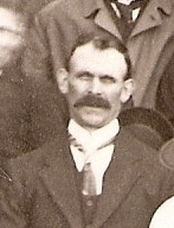
William Rabbitte, was the third member of this family to come to New Zealand. He was born at Turloughmore, Grange, on 3 November 1873, and was the seventh and final child of William (1823 -1897), and his wife Bridget, (1836 -1914.) He was their fifth son, and was born six years after the next youngest member of the family - his sister Bridget. The following is a copy of the details from his birth registration.
The christening record for William shows his sponsors as Thomas Fahey and Catherine Burke. Both these family names are from the Grange/Turloughmore area.
In his early adult years, William worked on the family farm at Turloughmore with his father and older brother Martin. When his father died in 1897, William was 23 years of age and he continued to work on the farm. He is also known to have helped with the building of a new house on Castle Lambert, for his sister Bridget. William married Honor Fahey, (sometimes spelt as Fahy), on 30 June 1902 in County Galway. William was 28 years of age and Honor was 21 at the time of their marriage.
In his early adult years, William worked on the family farm at Turloughmore with his father and older brother Martin. When his father died in 1897, William was 23 years of age and he continued to work on the farm. He is also known to have helped with the building of a new house on Castle Lambert, for his sister Bridget. William married Honor Fahey, (sometimes spelt as Fahy), on 30 June 1902 in County Galway. William was 28 years of age and Honor was 21 at the time of their marriage.
The Fahey family, were also long term residents of the Turloughmore/Grange district, and obviously the Rabbitt and Fahey families were well known to each other. (See the appendices for local area maps showing the exact location of the Fahey home, and its proximity to the Rabbitt home.) After their marriage William and Honor (known as Norah) continued to live at Turloughmore and three sons and one daughter were born between 1903 and 1910.
About 1909, Williams's oldest brother John, paid a return visit to Ireland and encouraged William to make his future life in New Zealand. Soon after John’s return to NZ, William and his wife, his three sons and baby daughter, left Ireland to travel to New Zealand. The family travelled on the steam ship the CORINTHIC which arrived in Wellington in early February 1911. The family then travelled onto Bluff in Southland, by coastal shipping. Therefore the arrival of the third Rabbitt brother in New Zealand occurred almost 28 years after the arrival of the second brother, - Patrick, who had arrived on 4 July 1882.
About 1909, Williams's oldest brother John, paid a return visit to Ireland and encouraged William to make his future life in New Zealand. Soon after John’s return to NZ, William and his wife, his three sons and baby daughter, left Ireland to travel to New Zealand. The family travelled on the steam ship the CORINTHIC which arrived in Wellington in early February 1911. The family then travelled onto Bluff in Southland, by coastal shipping. Therefore the arrival of the third Rabbitt brother in New Zealand occurred almost 28 years after the arrival of the second brother, - Patrick, who had arrived on 4 July 1882.
William was aged 36 years when he arrived in New Zealand. His wife was 29 years of age, their three sons were 6, 4, and 2 and their baby daughter was not yet 1 year old. Although the conditions aboard ship were much improved from the sailing ship era when John and Patrick came to NZ, travelling across the world with 4 children would have been testing at times.
William and his family made their way to Fernhills where William purchased a largely bush section adjacent to the land owned by William's oldest brother John. The particular area was known as "Harringtons". See the following local area map which pin points the land area owned by William, and its proximity to the railway line and the property of his older brother.
William and his family made their way to Fernhills where William purchased a largely bush section adjacent to the land owned by William's oldest brother John. The particular area was known as "Harringtons". See the following local area map which pin points the land area owned by William, and its proximity to the railway line and the property of his older brother.
It is known that when the family arrived in New Zealand William and his wife, did not speak English. William started shearing in the district and everyday he learnt a few words of English and then taught them to his wife.
After their arrival in NZ, two further children, both daughters, were added to the family.
Full details of this family are;
William Born 1903/04 In Ireland
Michael Born 1906 In Ireland
John William Born 1908 In Ireland
Delia Born 1910 In Ireland
Mary (Molly) Born 1913 In New Zealand
Patricia Norah Born 1921 In New Zealand
On the land at Harringtons, William was able to run a few cows and combined with harvesting and his skills as a shearer, he was able to get established in his new country. At some early stage after his arrival, William built a home for his family on the Harringtons property.
The following photograph taken in 1916, only five years after arriving in New Zealand, shows William with the members of his family.
After their arrival in NZ, two further children, both daughters, were added to the family.
Full details of this family are;
William Born 1903/04 In Ireland
Michael Born 1906 In Ireland
John William Born 1908 In Ireland
Delia Born 1910 In Ireland
Mary (Molly) Born 1913 In New Zealand
Patricia Norah Born 1921 In New Zealand
On the land at Harringtons, William was able to run a few cows and combined with harvesting and his skills as a shearer, he was able to get established in his new country. At some early stage after his arrival, William built a home for his family on the Harringtons property.
The following photograph taken in 1916, only five years after arriving in New Zealand, shows William with the members of his family.
In the booklet "Kauana/Fernhills School and District 1883 - 1983"; William (Bill), and Honor (Norah), are described as being a delightful couple. He was a good shearer and handed on that skill to his sons. They had a real Irish home. Norah had a shining black coal range and two big cast iron kettles that were always boiling. When anyone came to the door, she would first slide the kettle over and a cup of tea was on. Rolls of bacon hung from the ceiling of the kitchen.Also in the above booklet it is said the Rabbitt brothers "John and William Rabbitt often interrupted local dances, with their displays of the traditional Irish jigs". It is said William's conversation was interspersed with the repeated pattern, "Says I to him and him to me".
William and family lived in the Harringtons/Kauana district for the remainder of William’s life. He was a member of the local School Committee, from 1930 through until 1935.
The photo below thought to be taken about 1925 shows William and Honor with two of their sons.
William and family lived in the Harringtons/Kauana district for the remainder of William’s life. He was a member of the local School Committee, from 1930 through until 1935.
The photo below thought to be taken about 1925 shows William and Honor with two of their sons.
William passed away at Kauana on 7 August 1938. His cause of death is given as acute bacterial endocarditis, and a septic tooth. He was 64 years of age, and he was the second to die of the original three Rabbitt brothers who came to New Zealand. (William’s older brother Patrick, had passed away at Clinton in 1924 some 14 years before him.)
The following is a copy of the official registration of William's death.
The following is a copy of the official registration of William's death.
At the time of his death, William had lived in New Zealand for 28 years, and for all of that time he lived in the Kauana/Fernhills area.
He was buried at the Winton Cemetery on the 9th August 1938.
The following photo of William's wife Honor was taken in 1954.
He was buried at the Winton Cemetery on the 9th August 1938.
The following photo of William's wife Honor was taken in 1954.
Honor outlived her husband by 19 years and she passed away on 23 October 1957, aged 75 years. William and Honor are buried at Winton, with this headstone over their grave.
Summary of the life spans of the family of;
- William Rabbit (1823 - 1897) of Turloughmore, Galway, Ireland
and his wife
- Bridget Rabbit (nee Golding.) (1836 - 1914)
Having completed a broad description of the lives of the seven children of the above, it is interesting to now provide a list of the life span details for each.
The details in order of birth are;
John Born (Ireland) 1855 Married Mary Scully
Died at Invercargill, 1941. 10 children
Aged 87 years.
Patrick Born (Ireland) 1858 Married Ann Madden
Died at Wairuna, 1924. 7 children
Aged 66 years.
Mary Born (Ireland) 1859 Married William Corley
Died in Galway,1896. probably 7 children
Aged 38 years.
Timothy Born (Ireland) 1863. Died at Roscrea, Ireland, 1940
(Fr. Paul) Aged 77 years. No issue.
Martin Born (Ireland) 1865. Married Mary Clarke
Died, at Grange, 1932. 8 children
Aged 67 years.
Bridget Born (Ireland) 1868. Married Michael Holland
Died, Galway, 1949 6 children
Age 81 years.
William Born (Ireland) 1874 Married Honor Fahey
Died Kauana, 1938 6 children
Aged 64 years.
- William Rabbit (1823 - 1897) of Turloughmore, Galway, Ireland
and his wife
- Bridget Rabbit (nee Golding.) (1836 - 1914)
Having completed a broad description of the lives of the seven children of the above, it is interesting to now provide a list of the life span details for each.
The details in order of birth are;
John Born (Ireland) 1855 Married Mary Scully
Died at Invercargill, 1941. 10 children
Aged 87 years.
Patrick Born (Ireland) 1858 Married Ann Madden
Died at Wairuna, 1924. 7 children
Aged 66 years.
Mary Born (Ireland) 1859 Married William Corley
Died in Galway,1896. probably 7 children
Aged 38 years.
Timothy Born (Ireland) 1863. Died at Roscrea, Ireland, 1940
(Fr. Paul) Aged 77 years. No issue.
Martin Born (Ireland) 1865. Married Mary Clarke
Died, at Grange, 1932. 8 children
Aged 67 years.
Bridget Born (Ireland) 1868. Married Michael Holland
Died, Galway, 1949 6 children
Age 81 years.
William Born (Ireland) 1874 Married Honor Fahey
Died Kauana, 1938 6 children
Aged 64 years.
Other early arrivals in New Zealand of persons with the Rabbit(t) surname.
The research of this family has revealed several other people with the same surname, who were living in New Zealand from 1859 onwards. Without exception these other people came to New Zealand from Ireland and in mostcases they originated in County Galway. However, it has not been possible to prove any direct family links between any of these earlier Rabbit (t) settlers, and the three brothers who are the main focus of this review. Early correspondence (dated 1880), suggests a relative of the three brothers was living in Dunedin, prior to John’s arrival in New Zealand in 1879. It has not been possible to prove who this relation was - although some reasonably confident assumptions can be made.
The relative already in New Zealand, was probably Timothy Rabbit (1836 – 1886), who came from Galway, and who arrived in New Zealand about 1862. Timothy’s parents were Patrick Rabbit and Kate, formerly Conn, of Galway. Timothy married Bridget Ward in Dunedin in 1868. Bridget was from Galway and she arrived in NZ in 1863. They had two daughters; Kate born in 1869, and Ann born in 1871. Timothy is recorded on the 1875/76 electoral rolls for Roslyn, Dunedin. The 1881 electoral roll shows Timothy and John Rabbit on the same Roslyn roll. Considering John arrived in Port Chalmers in 1879, it is reasonable to assume these two Rabbit men living in the same area, were known to each other, and were probably related.
Timothy had an older brother in Dunedin, named Edward (1827 -1869). Edward was born in Galway and died of consumption in Dunedin Hospital on 26 June 1869. As he was 9 years older than Timothy, he may have been the first in NZ. He is not shown on any electoral rolls, and there is no other evidence of him. An Edward Rabbit was a sponsor at the baptism of Patrick Rabbit
(John’s brother) in Galway in 1858. If this is the same person, his arrival in NZ must be between 1858 and 1869. He is buriedat the Southern Cemetery in Dunedin
Timothy died in an accident, a fall of earth, while working on the Dowling Street extension in Dunedin, in 1886. His wife Bridget lived for many years at 61 Sligo Terrace, Roslyn, Dunedin. She died in 1924, aged 87 years and is buried at the Southern Cemetery in Dunedin. The eldest daughter Kate married Thomas Mayne, at St. Joseph's Church in Dunedin on 27 June 1898. Thomas Mayne was a police constable, and after their marriage, Thomas and Kate lived at Oamaru. The other daughter Ann did not marry, and continued to live at the Sligo Terrace address until her death in 1948/49.
Further evidence that Timothy may have been a relative of the original three brothers in New Zealand is contained in a letter to Mary Scully dated 1880. (See the actual words from that letter set out below). This letter is part of a continuing correspondence with Mary, who by that stage, clearly had met with her husband-to-be John Rabbit; (1855-1941). The writer of the letter is believed to be a Margaret Berwick, whose sister, Bridget, was married to a relation of John Rabbit. The letter contains the words; "I was very glad to hear that you met John Rabbit he is a nice fellow and a particular friend of ours, he is a relation of Bridget's husband." From other details it is clear the writer of the letter is living in Dunedin, and so is the previously mentioned Bridget. From the above it is now known that;
- John Rabbit had a relation living in Dunedin in 1880.
- This relation, (referred to above), was married to "Bridget".
A review of the Rabbitt people listed earlier in this section shows that Timothy Rabbit, (1836-1886), of Roslyn, Dunedin, meets the above criteria, and is most likely the relation referred to in the earlier letter. Here is an extract from the letter….
The relative already in New Zealand, was probably Timothy Rabbit (1836 – 1886), who came from Galway, and who arrived in New Zealand about 1862. Timothy’s parents were Patrick Rabbit and Kate, formerly Conn, of Galway. Timothy married Bridget Ward in Dunedin in 1868. Bridget was from Galway and she arrived in NZ in 1863. They had two daughters; Kate born in 1869, and Ann born in 1871. Timothy is recorded on the 1875/76 electoral rolls for Roslyn, Dunedin. The 1881 electoral roll shows Timothy and John Rabbit on the same Roslyn roll. Considering John arrived in Port Chalmers in 1879, it is reasonable to assume these two Rabbit men living in the same area, were known to each other, and were probably related.
Timothy had an older brother in Dunedin, named Edward (1827 -1869). Edward was born in Galway and died of consumption in Dunedin Hospital on 26 June 1869. As he was 9 years older than Timothy, he may have been the first in NZ. He is not shown on any electoral rolls, and there is no other evidence of him. An Edward Rabbit was a sponsor at the baptism of Patrick Rabbit
(John’s brother) in Galway in 1858. If this is the same person, his arrival in NZ must be between 1858 and 1869. He is buriedat the Southern Cemetery in Dunedin
Timothy died in an accident, a fall of earth, while working on the Dowling Street extension in Dunedin, in 1886. His wife Bridget lived for many years at 61 Sligo Terrace, Roslyn, Dunedin. She died in 1924, aged 87 years and is buried at the Southern Cemetery in Dunedin. The eldest daughter Kate married Thomas Mayne, at St. Joseph's Church in Dunedin on 27 June 1898. Thomas Mayne was a police constable, and after their marriage, Thomas and Kate lived at Oamaru. The other daughter Ann did not marry, and continued to live at the Sligo Terrace address until her death in 1948/49.
Further evidence that Timothy may have been a relative of the original three brothers in New Zealand is contained in a letter to Mary Scully dated 1880. (See the actual words from that letter set out below). This letter is part of a continuing correspondence with Mary, who by that stage, clearly had met with her husband-to-be John Rabbit; (1855-1941). The writer of the letter is believed to be a Margaret Berwick, whose sister, Bridget, was married to a relation of John Rabbit. The letter contains the words; "I was very glad to hear that you met John Rabbit he is a nice fellow and a particular friend of ours, he is a relation of Bridget's husband." From other details it is clear the writer of the letter is living in Dunedin, and so is the previously mentioned Bridget. From the above it is now known that;
- John Rabbit had a relation living in Dunedin in 1880.
- This relation, (referred to above), was married to "Bridget".
A review of the Rabbitt people listed earlier in this section shows that Timothy Rabbit, (1836-1886), of Roslyn, Dunedin, meets the above criteria, and is most likely the relation referred to in the earlier letter. Here is an extract from the letter….
The following summarises the details of other Rabbit(t) people in New Zealand from 1859 onward.
Those whose date of arrival in New Zealand is known are:
( i ) The first officially recorded arrival in New Zealand of a person with the Rabbit(t) surname occurred in 1859, with the arrival of one Patrick J. Rabbitt, who arrived at Auckland, on 19 October 1859. He travelled to New Zealand from the United Kingdom on the vessel; MERMAID. Information now available confirms this man returned to the UK in 1860.
( ii ) Mary Rabbitt, who was born in Galway in 1844 and arrived at Port Chalmers on 29 December 1862. She travelled to New Zealand on the vessel PLADDA and was 18 years of age at the time of her arrival. Six years later, on 3 February 1870, Mary married Patrick Hission at St. Joseph's Church, in Dunedin. (Hission is known to be a Galway family name.)
(iii) The next officially recorded arrival in New Zealand is that of Bridget Rabbit (born 1853), of Galway, who arrived at Port Chalmers on the vessel CHRISTIAN McAUSLAND, on 5 December 1872. The journey had departed from Glasgow in Scotland, on 27 September 1872 and Bridget was just 19 years of age, on her arrival in New Zealand. Bridget married Hugh Boyle at St. Joseph's Church in Dunedin, on 11 May 1878. Shortly after her marriage, Bridget nominated her father and brother (see under), to come to New Zealand. The last record of Bridget is on 22 November 1898, when she is known to have been living at Reefton, on the West Coast of the South Island. At this time she was 45 years of age, and her husband Hugh Boyle was still alive.
(iv) John Rabbit, the father of the Bridget, (iii) above) came to New Zealand on the vessel OAMARU arriving at Port Chalmers on 10 January 1879. There is some doubt about John's age because of variations in official records - he was born in Galway in 1816 or 1826. He died at Reefton on 22 November 1898, when he was either 82 or 72 years of age.
(v) John Rabbit was the son, and older brother of the above John and Bridget Rabbit. He was born in Galway in 1850, and travelled to New Zealand with his father, on the OAMARU, which arrived at Port Chalmers on the 10 January 1879. There is no other record of what became of John. The death certificate issued at the time of his fathers' death contains no reference to a living son and it is probable John had passed away prior to this time; i.e. prior to 22 November 1898.
(vi) Kate Rabbit, arrived at Port Chalmers on the vessel FORFARSHIRE, on 26 June 1883. Kate was born in Galway, in 1863, so she was about 20 years of age when she arrived in New Zealand. No other official record of Kate has been sighted.
In the earlier decades, i.e., 1870/80, there were other Rabbit(t) people residing in the Otago/Southland area, whose date of arrival in New Zealand has not been traced. These people were;
( i ) Margaret Rabbit, born in 1845, who was in Dunedin in 1870, and who on 5th February 1870 gave birth to Robert Henry McNabb Rabbit. At this stage Margaret was 25 years of age. It is not known what became of her or her child.
( ii) Thomas Rabbit, who was born in Ireland about 1841, and who is recorded as a settler in Milton, South Otago from 1878/79. The earliest records show his name spelt with one "t", however this changed to a "double t" in later years.Thomas farmed land in a district known as Akatore, in South Otago, and the name of Fairfax is also used to describe the district where he lived. Thomas was a bachelor during his life in New Zealand. In December1916, Thomas received serious injuries when he fell from his horse and dray in an accident near Milton. He was admitted to Dunedin Hospital where he died as a result of his injuries. He is buried at the Fairfax Cemetery near Milton, in South Otago.
(iii) Patrick Rabbitt, who was born at Parkroe, County Galway, Ireland, about 1848, and who married Honorah Kelly, at St Joseph's Church, Dunedin on 13 May 1876. They had a daughter, Mary, born at Fairfax in South Otago, on 24 March 1878. Patrick's occupation is given as a labourer. There is no further evidence of this family. Given the rareness of the surname, and that the above Patrick and Thomas Rabbitt were living in the same small district, it is reasonable to assume these men were related - however no evidence has been sighted which confirms this.
That completes the details of other Rabbit(t) people and families known to have been living in New Zealand, particularly the Otago/Southland area, in the 1870/1880 period.
Those whose date of arrival in New Zealand is known are:
( i ) The first officially recorded arrival in New Zealand of a person with the Rabbit(t) surname occurred in 1859, with the arrival of one Patrick J. Rabbitt, who arrived at Auckland, on 19 October 1859. He travelled to New Zealand from the United Kingdom on the vessel; MERMAID. Information now available confirms this man returned to the UK in 1860.
( ii ) Mary Rabbitt, who was born in Galway in 1844 and arrived at Port Chalmers on 29 December 1862. She travelled to New Zealand on the vessel PLADDA and was 18 years of age at the time of her arrival. Six years later, on 3 February 1870, Mary married Patrick Hission at St. Joseph's Church, in Dunedin. (Hission is known to be a Galway family name.)
(iii) The next officially recorded arrival in New Zealand is that of Bridget Rabbit (born 1853), of Galway, who arrived at Port Chalmers on the vessel CHRISTIAN McAUSLAND, on 5 December 1872. The journey had departed from Glasgow in Scotland, on 27 September 1872 and Bridget was just 19 years of age, on her arrival in New Zealand. Bridget married Hugh Boyle at St. Joseph's Church in Dunedin, on 11 May 1878. Shortly after her marriage, Bridget nominated her father and brother (see under), to come to New Zealand. The last record of Bridget is on 22 November 1898, when she is known to have been living at Reefton, on the West Coast of the South Island. At this time she was 45 years of age, and her husband Hugh Boyle was still alive.
(iv) John Rabbit, the father of the Bridget, (iii) above) came to New Zealand on the vessel OAMARU arriving at Port Chalmers on 10 January 1879. There is some doubt about John's age because of variations in official records - he was born in Galway in 1816 or 1826. He died at Reefton on 22 November 1898, when he was either 82 or 72 years of age.
(v) John Rabbit was the son, and older brother of the above John and Bridget Rabbit. He was born in Galway in 1850, and travelled to New Zealand with his father, on the OAMARU, which arrived at Port Chalmers on the 10 January 1879. There is no other record of what became of John. The death certificate issued at the time of his fathers' death contains no reference to a living son and it is probable John had passed away prior to this time; i.e. prior to 22 November 1898.
(vi) Kate Rabbit, arrived at Port Chalmers on the vessel FORFARSHIRE, on 26 June 1883. Kate was born in Galway, in 1863, so she was about 20 years of age when she arrived in New Zealand. No other official record of Kate has been sighted.
In the earlier decades, i.e., 1870/80, there were other Rabbit(t) people residing in the Otago/Southland area, whose date of arrival in New Zealand has not been traced. These people were;
( i ) Margaret Rabbit, born in 1845, who was in Dunedin in 1870, and who on 5th February 1870 gave birth to Robert Henry McNabb Rabbit. At this stage Margaret was 25 years of age. It is not known what became of her or her child.
( ii) Thomas Rabbit, who was born in Ireland about 1841, and who is recorded as a settler in Milton, South Otago from 1878/79. The earliest records show his name spelt with one "t", however this changed to a "double t" in later years.Thomas farmed land in a district known as Akatore, in South Otago, and the name of Fairfax is also used to describe the district where he lived. Thomas was a bachelor during his life in New Zealand. In December1916, Thomas received serious injuries when he fell from his horse and dray in an accident near Milton. He was admitted to Dunedin Hospital where he died as a result of his injuries. He is buried at the Fairfax Cemetery near Milton, in South Otago.
(iii) Patrick Rabbitt, who was born at Parkroe, County Galway, Ireland, about 1848, and who married Honorah Kelly, at St Joseph's Church, Dunedin on 13 May 1876. They had a daughter, Mary, born at Fairfax in South Otago, on 24 March 1878. Patrick's occupation is given as a labourer. There is no further evidence of this family. Given the rareness of the surname, and that the above Patrick and Thomas Rabbitt were living in the same small district, it is reasonable to assume these men were related - however no evidence has been sighted which confirms this.
That completes the details of other Rabbit(t) people and families known to have been living in New Zealand, particularly the Otago/Southland area, in the 1870/1880 period.
